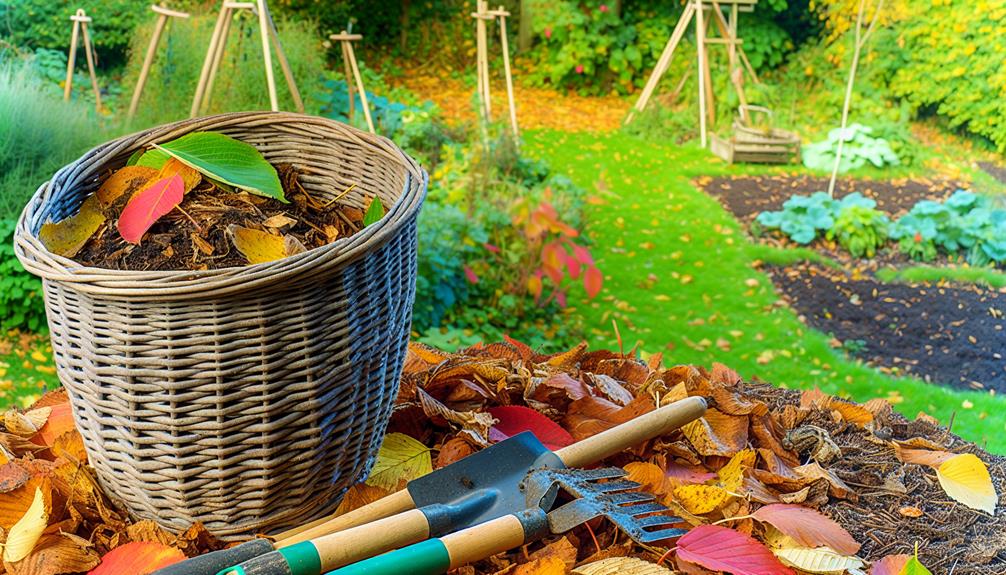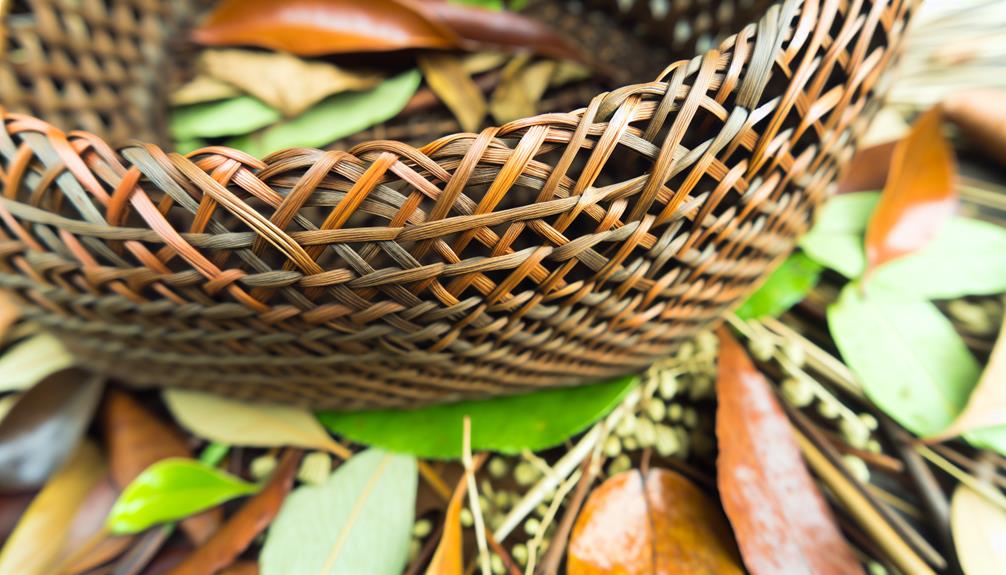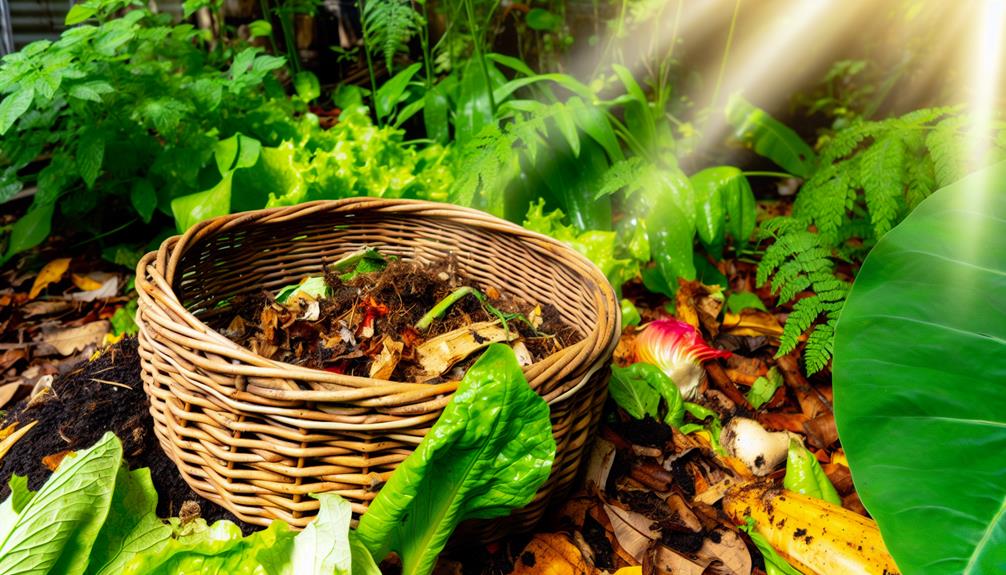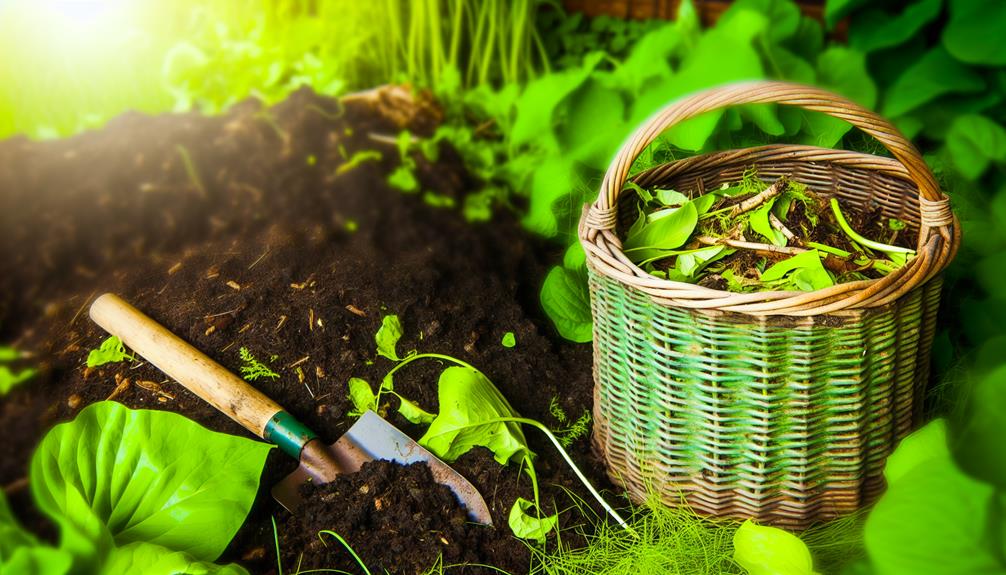

Wicker baskets, often crafted from natural materials like rattan, bamboo, or willow, present intriguing possibilities for sustainable living. Their inherent biodegradability makes them suitable for composting, enriching your garden soil when disposed of correctly.
However, not all wicker is created equal; understanding the nuances of basket composting is essential. As you explore the world of compost baskets, consider the impact of chemical treatments and the importance of preparing your wicker properly. Embrace the journey towards eco-friendly practices while ensuring your compost remains pure and beneficial.
Basket composting is an innovative and sustainable gardening technique that transforms organic waste into nutrient-rich fertilizer directly within garden plots. This method offers an efficient, space-saving approach to composting that allows gardeners to recycle kitchen and garden waste while simultaneously improving soil quality.

By using simple materials like bamboo baskets and organic waste, individuals can create a localized composting system that minimizes nutrient loss and prevents waste scattering.
Basket composting is a process where decomposable home garbage, garden waste, and leguminous leaves are allowed to rot in half-buried baskets within garden plots.
The technique involves:
Basket composting represents an accessible and environmentally friendly method for transforming waste into valuable garden resources.
When considering wicker for composting, it’s important to distinguish between natural and synthetic wicker materials. Natural wicker is made from natural fibers like rattan, bamboo, or willow. These materials are biodegradable and can break down naturally in a composting environment.
| Characteristic | Natural Wicker | Synthetic Wicker |
|---|---|---|
| Material | Organic materials (rattan, willow, sea grass) | Synthetic resins (PVC, nylon, polyethylene) |
| Durability | Less durable, prone to damage | Highly durable, weather-resistant |
| Weather Resistance | Poor – susceptible to moisture and sun damage | Excellent – UV inhibitors, stain-resistant |
| Indoor/Outdoor Use | Best for indoor use | Suitable for both indoor and outdoor environments |
| Maintenance | High maintenance, requires careful handling | Low maintenance, easy to clean |
| Cost | More expensive | Generally less expensive |
| Aesthetic | Natural, unique texture and appearance | Mimics natural look, more color options |
Being part of a community that values sustainability means making informed choices. Composting correctly not only benefits your garden but also contributes to environmental health. Always check the material before you add it to your compost. By doing so, you’re ensuring that your composting efforts are effective and eco-friendly.
Basket composting is an eco-friendly method of transforming kitchen waste into nutrient-rich organic fertilizer directly in your garden.

This sustainable technique allows gardeners to recycle organic materials while creating a localized composting system that enriches soil health and reduces waste.
Basket composting requires carefully selected materials that facilitate efficient organic waste transformation. The right combination of tools and ingredients ensures successful decomposition and nutrient-rich soil production. Selecting high-quality, diverse materials is crucial for creating a balanced composting environment.
Each component plays a specific role in breaking down organic matter, supporting microbial activity, and preventing potential issues like foul odors or pest attraction. Understanding the function of each material helps gardeners create an effective, sustainable composting system.
Implementing a basket composting method involves a systematic approach that transforms kitchen waste into valuable organic fertilizer. This process requires patience, attention to detail, and understanding of organic decomposition principles.
By following a structured methodology, gardeners can convert potentially wasted organic materials into nutrient-dense soil amendments. The step-by-step approach ensures optimal conditions for microbial activity, proper moisture retention, and efficient breakdown of organic matter, ultimately creating a sustainable gardening practice.
Preparation:
Layering Process:
Maintenance:
Monitoring:
Expected Outcome – After 2-4 weeks, you’ll have nutrient-rich, chemical-free compost ready to use in garden beds, potted plants, and terrace gardens.
Despite its many benefits, composting wicker baskets can pose several challenges that you should be mindful of to guarantee a successful composting process. One significant issue is pesticide contamination. Many wicker materials, especially those used in outdoor or garden baskets, might’ve been exposed to pesticides. These chemicals can persist in the material and, if composted, may introduce unwanted toxins into your compost pile, potentially harming beneficial microbes and plants.
Another concern is chemical treatments. Wicker baskets are often treated with various chemicals to enhance durability, resistance to pests, or for aesthetic purposes. These treatments can include varnishes, paints, or other synthetic coatings. When these chemically treated baskets break down in your compost, they can release harmful substances that can contaminate the compost, making it unsafe for your garden and plants.
To make sure that your compost remains healthy and free of contaminants, it’s essential to identify and avoid wicker baskets that have been treated with chemicals or exposed to pesticides. You can typically find this information on product labels or by contacting the manufacturer. Taking these steps will help you maintain a clean and effective composting process.
Basket composting is an innovative, space-efficient organic waste management technique that transforms kitchen and garden waste into nutrient-rich soil amendment. By using a simple basket structure, gardeners can quickly convert organic materials into valuable compost directly in their garden beds.

This method combines convenience, sustainability, and ecological responsibility, allowing individuals to reduce waste, improve soil health, and support local ecosystems through a straightforward, accessible composting approach.
Direct Nutrient Utilization:
Organic Waste Recycling:
Garden Protection and Efficiency:
Sustainable Agriculture:
Basket composting provides an efficient, eco-friendly method for organic waste recycling and soil enrichment, making it an excellent technique for home gardeners and small-scale agricultural practices.
Rather than composting your wicker basket, you might consider repurposing it for storage or decorative purposes around your home. Wicker, with its origins in ancient Egypt, has been traditionally used for creating durable and aesthetically pleasing items.
You can leverage this rich history by incorporating your wicker basket into various aspects of your household.
Here are some ideas:
| Use Case | Description |
|---|---|
| Storage Solution | Use it to store blankets, toys, or magazines. |
| Planter Holder | Place a pot inside for a chic plant display. |
| Laundry Basket | Ideal for holding dirty laundry or towels. |
| Decorative Piece | Add fairy lights for a cozy home accent. |
Wicker baskets are versatile home accessories that add warmth and natural texture to any space. However, their intricate weave can easily trap dust, dirt, and moisture, requiring careful and regular maintenance.

Proper cleaning not only preserves the basket’s appearance but also extends its lifespan, ensuring these beautiful storage solutions remain functional and attractive for years to come.
Wicker baskets come in various materials like rattan, reed, and willow, each requiring specific cleaning approaches. Understanding the basket’s composition is crucial for effective maintenance.
Regular cleaning prevents dirt accumulation, reduces potential allergen buildup, and maintains the basket’s structural integrity. By implementing consistent cleaning techniques, you can protect your wicker baskets from premature wear and keep them looking pristine and attractive in your home decor.
Dry cleaning is the first and most gentle method for maintaining wicker baskets. This technique removes surface dust and loose debris without introducing moisture, which can potentially damage the basket’s delicate fibers.
Regular dry cleaning prevents dirt from embedding deeply into the weave and helps maintain the basket’s natural texture and appearance. By dedicating just a few minutes to this simple process, you can significantly extend the life and beauty of your wicker storage solutions.
Wet cleaning requires careful execution to prevent water damage to your wicker basket. This method is ideal for more stubborn dirt and stains that cannot be removed through dry cleaning alone.
The key is to use minimal moisture and ensure thorough drying afterward. Wet cleaning helps remove accumulated grime, restore the basket’s natural color, and eliminate potential odors. Always test a small, inconspicuous area first to ensure the cleaning solution doesn’t cause discoloration or damage.
Materials Needed:
Cleaning Steps:
Mold and mildew can quickly compromise the structural integrity and aesthetic appeal of wicker baskets. These fungal growths thrive in humid environments and can spread rapidly if not addressed promptly.
Exploring how to effectively treat and prevent mold is essential for maintaining the basket’s quality. By using appropriate cleaning solutions and implementing preventive strategies, you can protect your wicker baskets from potential health hazards and unsightly fungal development.
Consistent maintenance is the key to preserving the longevity and appearance of wicker baskets. These tips go beyond simple cleaning and focus on comprehensive care strategies.
By adopting a proactive approach to basket maintenance, you can prevent common issues like fiber weakening, color fading, and structural deterioration. Regular care not only keeps your baskets looking beautiful but also ensures they remain functional and valuable home accessories for years to come.
You shouldn’t compost painted wicker, buddy. Paint types often contain chemicals that can harm the environment. Instead, consider upcycling or disposing of it properly to minimize your environmental impact and contribute to sustainability.
Natural wicker decomposes in roughly 10-15 years, depending on weather conditions. You’ll see it go through various decomposition stages, from breaking down to forming nutrient-rich soil, making you feel connected to the earth’s natural cycle.
You’ll want to check for any wicker dyes or chemical treatments on your wicker basket. These chemicals can harm compost. Always opt for untreated, natural wicker to make sure your compost stays healthy and chemical-free.
Yes, you can mix wicker materials with food scraps in your compost. Just make sure proper compost layering to balance the carbon and nitrogen. Your community of composters will appreciate your commitment to sustainable practices!
You’re wondering if treated wicker can be recycled instead of composted. Unfortunately, treated wicker recycling isn’t usually possible due to chemicals. For proper disposal, consider your local waste management guidelines for treated materials.
The process of composting wicker baskets can be quite beneficial, provided they are made from natural materials such as rattan, bamboo, or willow. Proper preparation is essential; removing synthetic components and cutting the wicker into smaller pieces enhances decomposition. While basket composting enriches the compost heap, awareness of potential chemical treatments is crucial to avoid contamination.
Ultimately, if composting isn’t suitable, alternative eco-friendly options like recycling or repurposing the basket contribute positively to sustainability efforts. Embracing these practices reflects a commitment to environmental health and responsible waste management.
